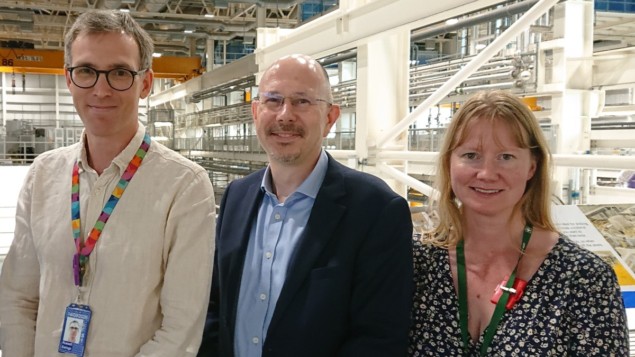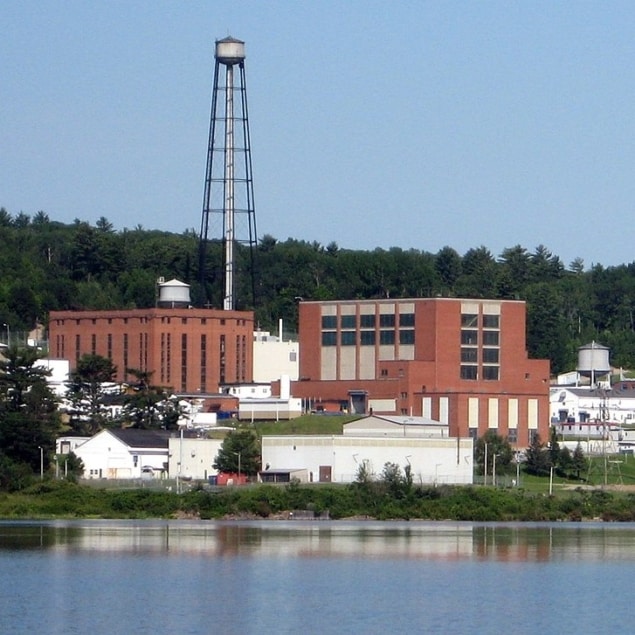
The phrase “I was like a child in a sweet shop” is probably the best way to describe my recent visit to the Harwell Science and Innovation Campus. Set in the bucolic Oxfordshire countryside about 60 miles west of London, the site is home to several of the UK’s National Laboratories, which are run by the Science and Technology Facilities Council (STFC). Indeed, one of the best parts of my job is visiting places like Harwell and chatting with the brilliant people who work there.
As well as touring several labs, I also interviewed the particle physicist Dave Newbold, who is the STFC’s executive director, national laboratories science and technologies. You can listen to that wide-ranging interview in an upcoming episode of the Physics World Weekly podcast.
But first, I am going to devote a series of blog posts to the facilities I toured at Harwell. First up is the ISIS Neutron and Muon Source, where I was given a fascinating tour by Philip King, Alison Oliver and Russell Ewings.
Two targets
King was quick to point out that ISIS is not only the first spallation source used for neutron science – it is the only spallation source that employs two targets. You may be wondering what a spallation source is – but let’s back up a bit and explore why beams of neutrons – and indeed muons – are used across a wide range of sciences.
The neutrons created at ISIS and other neutron-science facilities are slow moving and therefore have de Broglie wavelengths that are on par with the distances between adjacent atoms in liquids and solids. As a result, beams of these neutrons can be used in diffraction studies of the structure of materials. Unlike X-rays with comparable wavelengths, neutrons can travel much further into most materials so they are a more effective probe of bulk properties.
Neutrons can also collide with atoms in a sample and exchange energy, which means that they can probe the vibrational properties of matter. What is more, neutrons also interact magnetically with materials – so they can probe magnetic properties.
Directional decay
And what about muons, what are they good for? Muons are subatomic particles with magnetic spin. When they are implanted in a sample, the muons’ spins are affected by the local magnetic properties of the material. The muons then decay to a positron, which is emitted from the sample in a direction that is indicative of the spin of the muon. Therefore, by detecting the emitted positrons, information is gleaned about the magnetic properties of the sample.
At ISIS, neutrons and muons are created by firing pulses of 800 MeV protons at solid targets and the protons are created by a synchrotron accelerator at the heart of the facility. According to the SFTC, about 1200 experiments per year are done at ISIS. These involve about 3000 researchers from the UK and around the world, and result in about 600 publications per year.
Neutron science facilities like ISIS have a special place in my heart because a lifetime ago when I was an undergraduate physics student, I spent a glorious summer at Chalk River Laboratories – which in 1988 was run by Atomic Energy of Canada (AECL). Located on the shore of the Ottawa River, and on the edge of the Canadian wilderness, Chalk River was home to the AECL’s Neutron and Solid State Physics Branch. The branch has included some of the world’s most eminent neutron scientists – something that I admit I was oblivious to when I first arrived.

I don’t think that I accomplished much scientifically that summer. However, I was lucky because my supervisor back at the University of Guelph – the neutron-scattering pioneer Peter Egelstaff – allowed me to help out with some of the other research being done at Chalk River’s Nuclear Reactor Universal (NRU) neutron source.
Some of my many fondest memories include rotating a large industrial component in a neutron beam to look for defects, and learning how neutrons are used to study biological membranes. As I discovered at Harwell, both of these things – and much more – are done at ISIS today.
But one of the best parts of being at Chalk River was the group tea/coffee breaks, for which attendance was compulsory. That summer, the hot topic of discussion at these breaks was the relative merits of spallation neutron sources compared to reactor sources like NRU. I can remember having the spallation process carefully explained to us students – and it sticks in my mind to this day that the term is derived from the word “spall”, which means to chip away at something.
During my visit to Harwell, I learned that just a few years before my summer stint at Chalk River, ISIS had opened as the world’s first spallation source for neutron science. I’m guessing that by 1988, the first scientific papers from ISIS were being published, piquing the interest of the global neutron community. So, 35 years and a visit to ISIS later, I now know why spallation was such a hot topic that summer on the banks of the Ottawa River.
- SEO Powered Content & PR Distribution. Get Amplified Today.
- PlatoData.Network Vertical Generative Ai. Empower Yourself. Access Here.
- PlatoAiStream. Web3 Intelligence. Knowledge Amplified. Access Here.
- PlatoESG. Carbon, CleanTech, Energy, Environment, Solar, Waste Management. Access Here.
- PlatoHealth. Biotech and Clinical Trials Intelligence. Access Here.
- Source: https://physicsworld.com/a/neutrons-and-muons-isis-provides-both-for-a-wide-range-of-science/
- :has
- :is
- :not
- :where
- $UP
- 3000
- 60
- a
- About
- AC
- accelerator
- accomplished
- According
- across
- adjacent
- admit
- ago
- allowed
- also
- am
- an
- and
- ARE
- around
- arrived
- AS
- At
- attendance
- away
- back
- Banks
- BE
- Beam
- because
- before
- being
- BEST
- between
- Bit
- Blog
- Blog Posts
- both
- Branch
- breaks
- brilliant
- Building
- but
- by
- CAN
- Canada
- Canadian
- carefully
- centre
- chatting
- child
- chip
- click
- Collide
- community
- comparable
- compared
- component
- created
- day
- Derived
- describe
- direction
- Director
- discovered
- discussion
- done
- Dont
- Edge
- Effective
- employs
- energy
- episode
- exchange
- executive
- Executive Director
- experiments
- explained
- explore
- facilities
- Facility
- fascinating
- few
- firing
- First
- For
- from
- further
- given
- Global
- going
- good
- Group
- had
- Have
- having
- Heart
- help
- Home
- hosts
- HOT
- How
- However
- HTTPS
- i
- image
- in
- include
- included
- indeed
- industrial
- information
- Innovation
- interact
- interest
- Interview
- interviewed
- into
- involve
- issue
- IT
- Job
- jpg
- just
- King
- Know
- laboratories
- Labs
- large
- later
- learned
- learning
- left
- lifetime
- like
- local
- located
- London
- Look
- many
- material
- materials
- Matter
- max-width
- May..
- me
- means
- Memories
- merits
- MEV
- mind
- more
- most
- moving
- much
- my
- National
- Neutron sources
- neutrons
- now
- nuclear
- of
- on
- ONE
- only
- open
- opened
- Other
- out
- papers
- parts
- People
- per
- Peter
- Physics
- Physics World
- pioneer
- Place
- Places
- plato
- Plato Data Intelligence
- PlatoData
- podcast
- Point
- Posts
- probably
- probe
- process
- properties
- protons
- provides
- publications
- published
- Quick
- range
- reactor
- recent
- relative
- remember
- research
- researchers
- result
- right
- River
- Run
- Science
- SCIENCES
- scientific
- scientists
- seen
- Series
- set
- several
- site
- slow
- So
- solid
- some
- something
- Source
- Sources
- special
- spent
- Spin
- spins
- State
- structure
- Student
- Students
- studies
- Study
- subatomic particles
- such
- summer
- sweet
- targets
- Technologies
- Technology
- term
- that
- The
- the UK
- the world
- then
- There.
- therefore
- These
- they
- things
- think
- this
- thumbnail
- to
- today
- topic
- Tour
- toured
- touring
- travel
- true
- two
- Uk
- Universal
- university
- unlike
- upcoming
- us
- used
- Visit
- was
- Way..
- WELL
- were
- West
- What
- What is
- when
- which
- WHO
- why
- wide
- Wide range
- with
- wondering
- Word
- Work
- world
- world’s
- year
- years
- You
- zephyrnet













